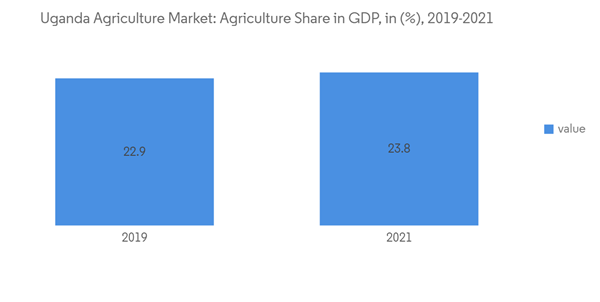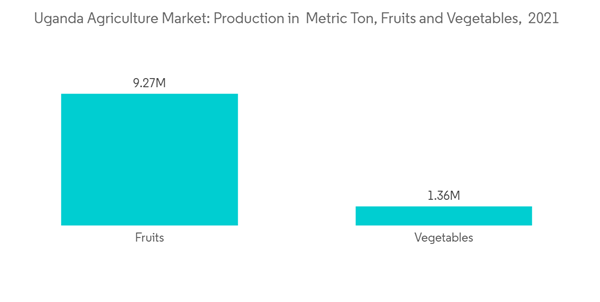Key Highlights
- Agriculture has always been of great importance to Uganda. It is the primary sector of the Ugandan economy and the main employer. Over the coming years, the agriculture sector is expected to be the key contributing factor in the country's efforts to decrease poverty and attain economic growth. Uganda has one of the fastest population growth rates. As per the UN World Population Prospects statistics, the population of Uganda in 2022 was 47,249,585, a 3.04% increase from 2021, which is the principal driver for the growth in the consumption of crops in Uganda. However, limited production owing to major productivity restraints, due to the unavailability of good quality seeds and proper irrigation, as well as lack of linkages between formal and informal seed sectors, contribute the most toward restraining the development of the agriculture sector in Uganda.
- For decades the Ugandan federal government has been highly supportive of agriculture. It has been supporting the agriculture industry with a number of policies, trying to stabilize the output and seeking out ways to make sure the sector is growing healthily and sustainably. There is broad political consensus as to the need for labor, land, and tax reform to help the sector reach its potential. Due to supportive policies, the agriculture sector's performance has been improving steadily in recent years in Uganda.
Uganda Agriculture Market Trends
Agriculture Contributes Highly to Uganda’s GDP
- For several years, agriculture has been the backbone of Uganda. The country has a warm climate, ample fertile land, and periodical rainfall. According to the UN FAO, Uganda's fertile agricultural land has the potential to feed 200 million people. Eighty percent of Uganda's land is arable, but only 35% is cultivated. In 2021-22, agriculture accounted for approximately 23% of GDP and 33% of export earnings. The UBOS (Uganda Bureau of Statistics) estimates that about 70% of Uganda's working population is employed in agriculture.
- The agricultural sector has benefited from government efforts toward strengthening the country's competitive advantage in the agricultural production sector. For instance, in June 2022, the Ugandan government contributed nearly USD 10 million to the latest phase of a South-South Cooperation project focused on crop and animal production with the FAO and the Chinese government after the first two phases yielded dramatic results, including a quadrupling of rice production per hectare.
- An increase in the adoption of good agricultural practices and investments in agriculture by private players are expected to boost the growth of agriculture in Uganda during the forecast period. Based on data from the Uganda Bureau of Statistics in 2022, crop production was the most widespread agricultural activity, with 99% of agricultural households engaged in it. Crops are produced predominantly for their own consumption, with 14% of agricultural households cultivating exclusively for their own consumption and an additional 68% cultivating mainly for own consumption, although with some sales.
Fruits and Vegetables Dominate the Ugandan Agriculture Market
- In Uganda, consumers are discovering the link between healthy food and their well-being and switching to fruits and vegetables. In addition, with the rising health consciousness, there is an increasing consumption trend of varieties of off-season fruits, which are being met by rising imports. Even a larger number of smallholders are likely to be involved in the production of fruits and vegetables for the domestic and regional markets.
- Uganda produces and processes large quantities and varieties of fruits, including pineapples, mangoes, passion fruit, and tomatoes. There is also much room to improve the use of machinery and advanced technologies in the agriculture sector. The country has made efforts to integrate new agricultural technologies to improve the sector's efficiency and increase land productivity.
- Apples, citrus, grapes, bananas, litchis, peaches, pineapples, potatoes, tomatoes, onions, sweet corn, beetroots, and avocados are some of the major fruits and vegetable crops identified that are expected to show high growth potential in the regional market during the coming years. The growing awareness of healthy diets and environmental issues is predicted to boost the demand for organic fruits and vegetables. Uganda's climate and landscape are ideal for meeting this demand for organic fruits and vegetables. It has a bimodal rainfall pattern, several water bodies and rivers, and large agricultural land.
Uganda Agriculture Industry Overview
Additional Benefits:
- The market estimate (ME) sheet in Excel format
- 3 months of analyst support
This product will be delivered within 2 business days.










